The HTC 10 Review
by Joshua Ho on September 19, 2016 8:00 AM ESTSystem Performance
One of the major areas worth discussing when it comes to mobile devices is computing performance. As much as OEMs try to not talk about this, ultimately what distinguishes a smartphone from a featurephone or simple flip phone is dramatically improved compute. Running a web browser, running a full Linux OS with apps that require JIT or AOT compilation are all tasks that demand large amounts of system memory and compute. Similarly, any kind of 3D game is going to require quite a bit of compute power and memory in general. As mentioned in previous reviews a major focus for this year has been trying to make our benchmarks more focused on real-world performance, so we’ll be better able to show how the HTC 10 actually performs relative to other devices on the market.
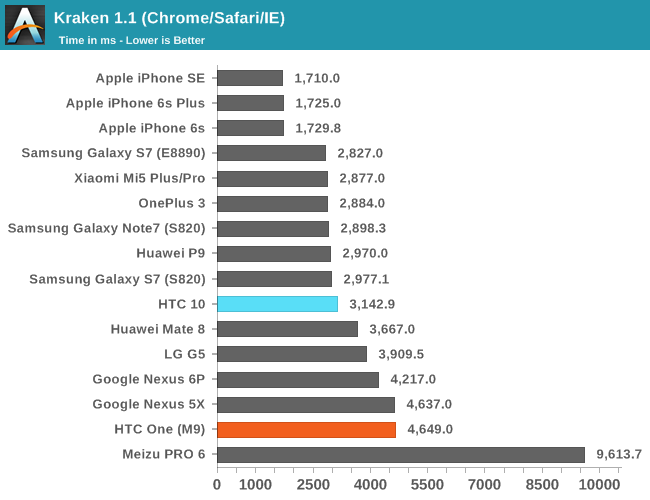
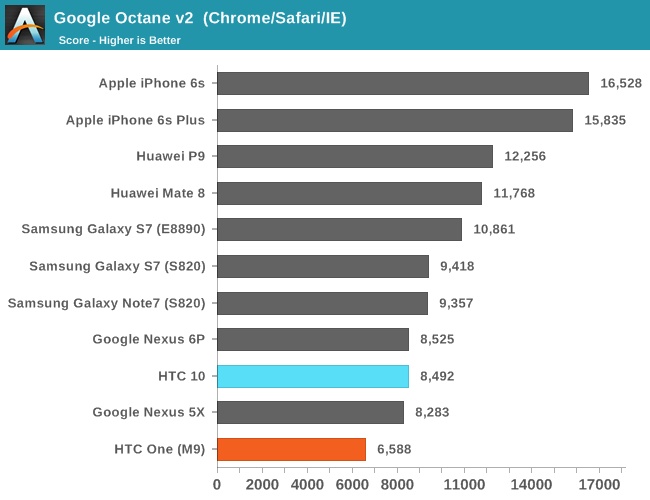
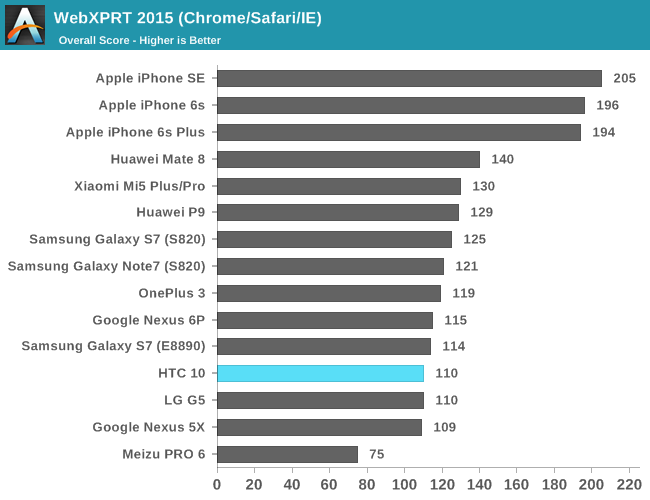
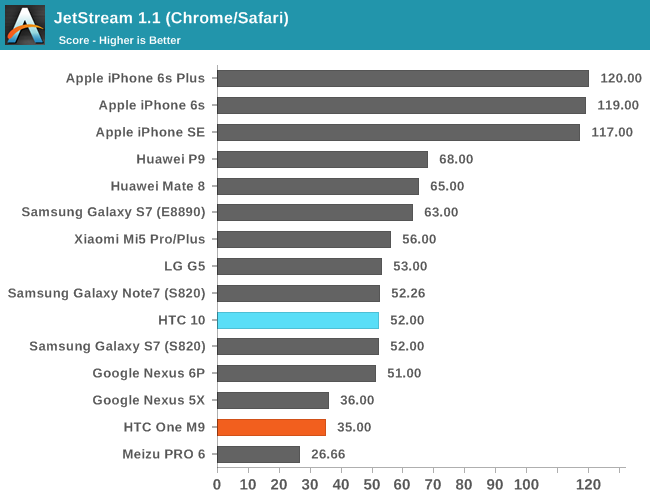
In the basic browser benchmarks, we can see that the HTC 10 is pretty much on par with all other Snapdragon 820 devices. This shouldn't really come as a surprise given how much of an optimization target all of these benchmarks are for the OEMs and SoC vendors, but performance in general on Snapdragon 820 is not necessarily great for web browsing with Chrome.
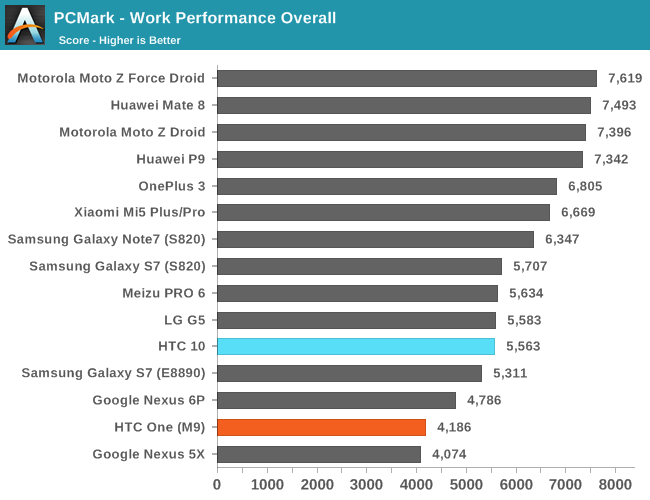
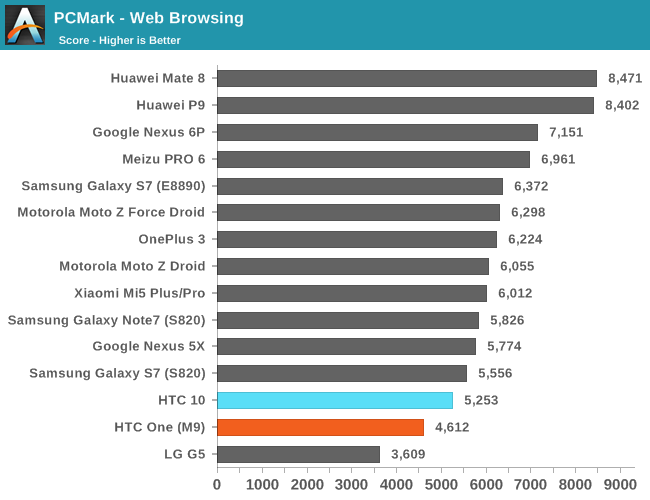
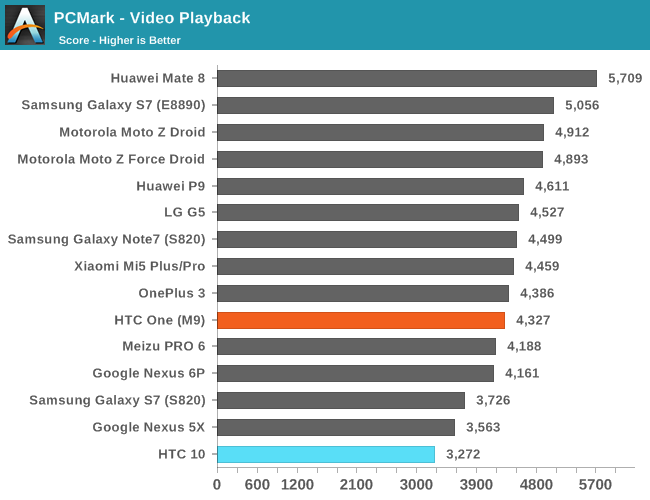
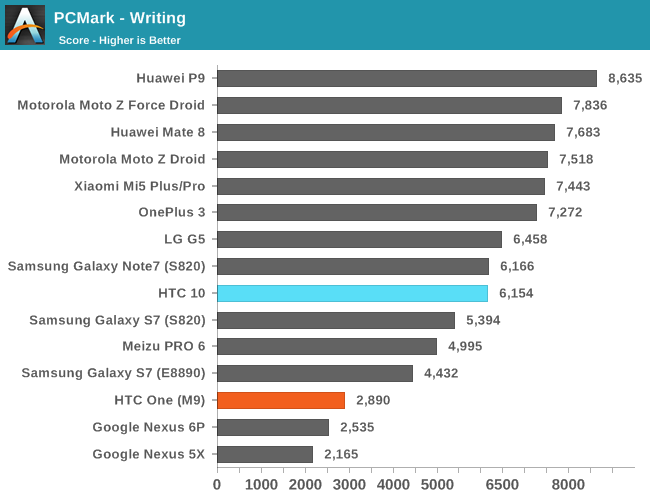
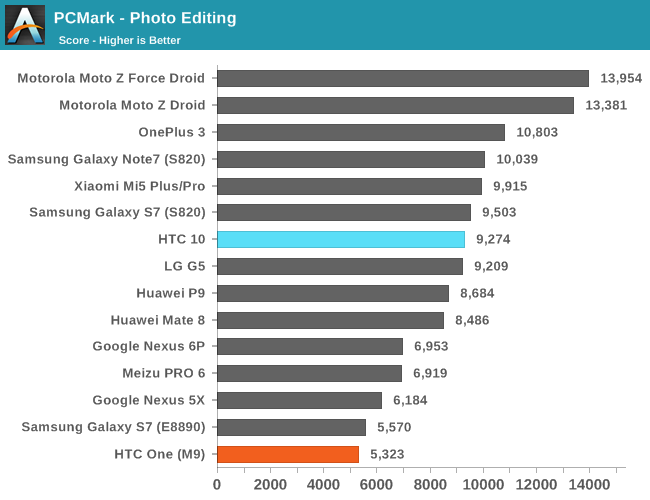
PCMark is very sensitive to DVFS changes in most cases so it's interesting to see how closely it performed to the Galaxy S7 and G5. What is notable here is the poor showing in video playback, which persists even if you use HTC's CPU cheats which are still accessible from the developer settings. The average scores that PCMark records is significantly higher than what I can achieve with the HTC 10 unless I enable high CPU performance mode. Determining what this means has been left as an exercise to the reader.
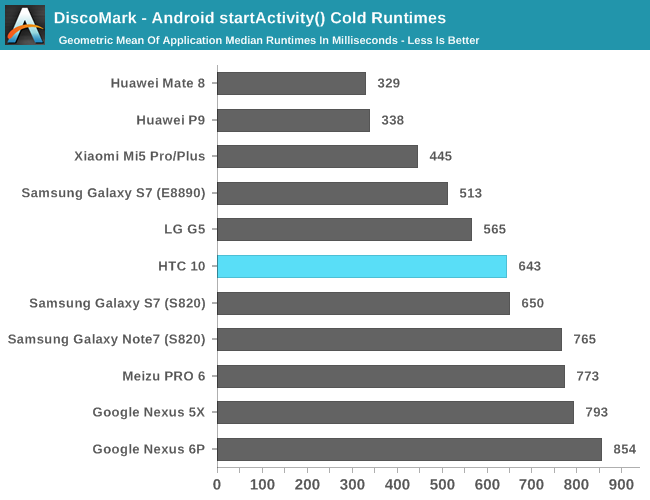
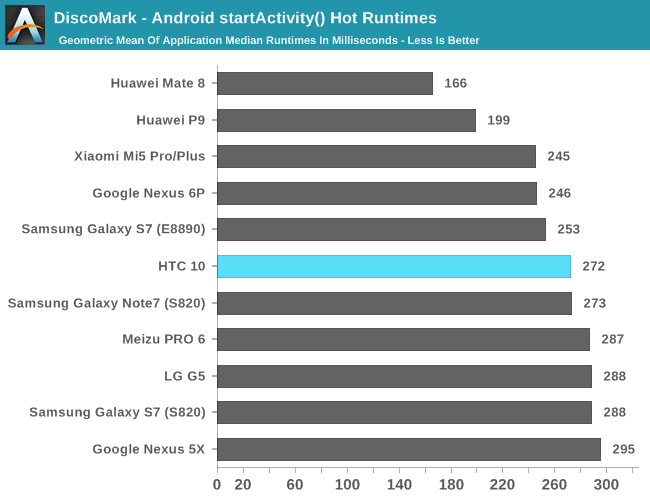
Looking at the HTC 10 overall results it might be tempting to simply suggest that overall performance is comparable to the Galaxy S7 with S820 but when you look at the individual breakdown the main reason why the HTC 10 seems to be so slow is because the location provider in Maps is causing its launch time to be significantly higher than most phones I've seen before. In just about every other situation the Galaxy S7 is significantly behind the HTC 10. Overall, I think the HTC 10 performance is in line with what I'd expect for a Snapdragon 820 phone here.










183 Comments
View All Comments
MobiusPizza - Tuesday, September 20, 2016 - link
Gosh that sentence is quite a mouthful
asfletch - Tuesday, September 20, 2016 - link
Agreed. Also re the content - is it surprising to anyone else that UFS solutions don't have a clearer advantage over eMMC? I mean my 2014 Note 4 gets about 19/7 on Random Read/Write with the same Androbench settings. According to these charts, that's better than the current Note 7. Also the HTC 10 here on test beats all of the UFS phones handily for Sequential Write speed.What's up with that? Is it the benchmark?
Guitahero - Tuesday, September 20, 2016 - link
What happened with the deep audio analysis from anandtech?JKJK - Tuesday, September 20, 2016 - link
Indeed! I miss them too!winjay - Tuesday, September 20, 2016 - link
"for its size I don’t believe there’s another Snapdragon 820 device with better battery life."Sony usually does wonders with battery life. Have you checked Xperia XA battery life?
Vagabondjonez - Tuesday, September 20, 2016 - link
with a 2k display he probably meantwinjay - Tuesday, September 20, 2016 - link
Also this phone is said to have an amazing DAC. How is the audio output?Ro_Ja - Tuesday, September 20, 2016 - link
The front looks like a Samsung Galaxy.amosbatto - Wednesday, September 21, 2016 - link
This review (and every other review I have ever read) doesn't cover the most important issue, which is the longevity of the phone. Here are the issues which I suggest that a review should cover:1. We all know that the battery will die after 2 years. Every phone which has a replaceable battery should automatically get a higher rating, just because it will probably last longer than one which doesn't. If a phone has a sealed case, the reviewer should try to open the case and give readers an idea how hard it will be to replace the battery. If the case is glued together, if the battery is glued to the case or if it is impossible to buy replacement batteries on the internet, then the review should let us know.
2. Reviews should emphasize the amount of storage space a phone has and how expandable the phone is, because this has a big impact on how long the phone will last. If a phone is limited to 32 gigabytes of storage, then the phone will probably not last more than 2 years, because people tend to buy new phones once they run out of space. Trying to decide what apps to uninstall, what music to remove, what photos to delete, etc. is such a painful process, that many people simply buy a new phone. Reviews should really knock phones which don't have a MicroSD slot to expand storage and I would love to see some benchmarking on the difference in speed between the internal NAND and a normal MicroSD.
Frankly, I wish that smartphone manufacturers would offer us phones with two MicroSD slots, where one is used to expand the storage for apps on the phone and the second is the memory that we can remove to transfer files to our PC.
Another thing that reviews should cover is how hard is it insert and extract a MicroSD card. On my HTC Sensation from 2011, it was very easy to pop the MicroSD card in and out of the computer, but it can't be done without a special tool on my Moto X Pure Edition. Not a single review ever covers how hard it is to insert and extract the MicroSD card, but this is essential information for people like me who intend to keep their phones for many years.
3. Every review should mention how good the manufacturer is about offering security updates and OS upgrades to its phones, which are essential for extending the life of the phone. HTC has an excellent track record of offering fast updates when a new version of Android is released, whereas Samsung does not. Every review comparing an HTC phone to a Samsung phone should mention this difference, because it will influence the buying decisions of people who care about the longevity of their phones.
4. Another way to extend the life of a phone is to install an OS that doesn't come from the manufacturer. If the manufacturer stops offering upgrades, then we have the freedom to install CyanogenMod or another mod to get the new features in the latest version of Android. No review ever covers how hard it is to unlock the bootloader and install a mod in the phone, but this is essential information for a phone buyer who wants to be able to keep upgrading the phone. Does the manufacturer offer for free the code to unlock the bootloader and does it have a policy of voiding the warranty if a mod is installed? Five years ago when I bought my Sensation, HTC had the best mod policies in the industry, but I have no idea who is best today and this review didn't mention it.
Another piece of essential information is how standard the hardware is and how likely mods will be developed for the phone. For example, the SoC on the HTC 10 is a standard Qualcomm Snapdragon 820, so it is highly likely that mods will be made for this phone, whereas it is highly unlikely that mods will ever be created for a custom SoC made by Huawei, Samsung or Apple. Yes, that custom SoC probably processes a couple milliseconds faster, but frankly most people will never notice the difference.
5. Another way to extend the life of a phone is to turn it into a PC. I frankly don't see the point of buying a flagship phone like the HTC 10 which costs $600, but I might consider it if I know that it can be used as a low cost PC. Kudos to this review for at least mentioning that the HTC 10 supports Slimline and Android 7, but it doesn't explain why that is important. The phone has the necessary hardware and software to be hooked up to a monitor and bluetooth keyboard and mouse, so it can be used as a PC with multiple windows and a mouse pointer. I would have loved to read a review about how well this works with the HTC 10.
Reviewers spend an inordinate amount of time covering differences in processing speed and other minutiae which most people will never notice when using a phone, but they don't provide the most essential information to help people choose phones with long lifespans. Part of the reason is that reviewers are the type of people who get a new phone every year, so they don't worry about the battery wearing out. However, I think a more important factor is that fact that sites like AnandTech rely on advertising from the same manufacturers who they are reviewing. Manufacturers of smartphones and other electronic devices promote planned obsolescence as a way to increase their sales. A reviewer who dwells too much on the fact that a phone is designed to be thrown away after two years probably won't get much advertising and is unlikely to get free samples to review.
Apple has always had some of the worst policies in the industry in terms of planned obsolescence, but within the last 5 years the entire phone industry has started to copy Apple in designing sealed black boxes which are difficult to open and even harder to fix. Yet, I have not seen a single review of the iPhone 7 or any of the other recent smartphones which even mentions how hard it is to fix the phone or even replace the battery. If the reviewers don't mention it, then consumers won't think to check and the phone industry will conclude that consumers don't want fixable and modifiable phones, so they will offer more and more Apple-like devices.
Extending the life of smartphones is not just a way to save consumers money. One of the biggest ecological problems on the planet is the fact that 1.5 billion smartphones will be manufactured this year and most of them will be junked within 2 years. More smartphones are manufactured today than all the other ICT devices combined (servers, routers, desktop and notebook PCs, tablets, gaming consoles, cameras, televisions and advanced wearables). The amount of energy, metals and other vital resources which are wasted every year in making throwaway devices is astounding. If we estimate that the average smartphone and its charger weighs 150 grams, that means we are generating 225,000 metric tons of eventual e-waste every year, which is toxic and needs special treatment.
Even more alarming is the amount of greenhouse gas emissions being generated to manufacture all these smartphones. Apple estimates that 83.6 kg of CO2-equivalent were emitted to manufacture and transport its iPhone 6 to point of sale, whereas using an iPhone for a year emits 3.5 kg CO2-e and recycling it at the end of its life emits 1.0 kg CO2-e. Of course, Apple didn't include all the energy to operate the cell towers, internet servers and routers, etc. that are used by an iPhone, but manufacturing a smartphone clearly has far more environmental impact than using it, so the best way to lower the environmental impact is to make the phone last as long as possible in order to avoid manufacturing a new phone.
Apple does not explain how it calculates its emissions, but it is highly likely that Apple did not include the SF6 which was emitted in manufacturing its screens or all the other types of greenhouse gases which often get overlooked. It also probably doesn't include in its emissions all the advanced processing to make the ultrapure chemicals, water and gases which are used in silicon and flat screen fabs. Today's crop of smartphones probably have an even higher environmental impact, considering that they are using larger screens, more memory and more processing cores than the iPhone 6, which had a 4.7in screen, 1 GB of RAM and 2 processing cores. Now-a-days, 5-6in screens, 2-4GB of RAM and 4-8 processing cores are the norm, so we can conservatively estimate that manufacturing today's smartphone will emit 100 kg CO2-e. For the 1.5 billion smartphones produced in 2016, that means 150,000 metric tons of CO2-e.
Allan_Hundeboll - Wednesday, September 21, 2016 - link
You def. have a point